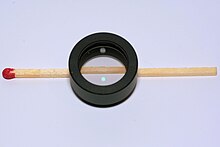Barlow lens

The Barlow lens is named after its inventor Peter Barlow named lens , the focal length and thus the magnification of a telescope or microscope increased. It is inserted into the focuser in front of the eyepiece . The Barlow lens is a diverging lens. Standard Barlow lenses double or triple the effective focal length of a lens.
The Barlow lens is located at the end of a longer tube, the so-called spacer tube . Its length together with the focal length of the lens determine the magnifying effect. The actual lens body can in most cases be separated from the spacer tube and z. B. be screwed directly to the field side of an eyepiece. However, this reduces the magnifying effect of e.g. B. 2-fold to 1.4-fold.
Some eyepieces have a built-in Barlow lens as standard, e.g. B. in the receptacle. With such eyepieces (or others that have installed another focal length changing element), the use of an additional Barlow lens should be avoided, as otherwise the image quality suffers too much. In addition, there are often mechanical problems as the foremost lens elements are too close to the thread and could touch the Barlow element.
Shaple lens
The opposite of a Barlow lens is a so-called Shapley lens (after Harlow Shapley ), which shortens the effective focal length and at the same time increases the light intensity. The shape lens is a collecting lens. Both Barlow and Shapleyl lenses with indications such as '2x' or '0.55x' are available commercially. This means that the focal length has to be doubled or multiplied by a factor of 0.55. However, the value only applies in conjunction with very specific other eyepiece or photo adapters. Both types of lenses can be used for both visual observation and photography. In photography, the following applies to the enlargement of the image compared to the same lens without a Barlow lens:
Here f means the focal length of the lens and a the distance between the (Barlow) lens and the image plane. With a Barlow lens (diverging lens, f <0) the result is v > 1 and thus an extension of the effective focal length of the overall optical system. With a shape lens (converging lens, f > 0), v <1 results, i.e. a shortening of the effective focal length of the overall system.
Individual evidence
- ^ Michael A. Covington: How to Use a Computerized Telescope Practical Amateur Astronomy . Cambridge University Press, 2002, ISBN 978-0-521-00790-0 , pp. 92 ( limited preview in Google Book search).
- ^ Günter D. Roth: Compendium of Practical Astronomy Volume 1: Instrumentation and Reduction Techniques . Springer Science & Business Media, 2012, ISBN 978-3-642-45688-6 , p. 224 ( limited preview in Google Book search).




